MAKITA Angle Grinder M9502R / M9503R
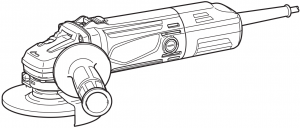
SPECIFICATIONS
| Model: |
M9502R |
M9503R |
| Wheel diameter |
115mm (4-1/2″) |
125mm (5″) |
| Max. wheel thickness |
7.2 mm |
|
| Spindle thread |
M14 x 2 or 5/8″ (country specific) |
|
| Rated speed (n) |
11,000min-1 |
|
| Overall length |
281mm |
|
| Net weight |
2.0kg |
2.1kg |
| Safety class |
|
- Due to our continuing program of research and development, the specifications herein are subject to change without notice.
- Specifications may differ from country to
- Weight according to EPTA-Procedure 01/2003
Symbols
The following show the symbols used for the equipment. Be sure that you understand their meaning before use.
 |
Read instruction manual. |
 |
Wear safety glasses |
 |
DOUBLE INSULATION |
 |
Only for EU countries Do not dispose of electric equipment together with household waste material! In observance of the European Directive, on Waste Electric and Electronic Equipment and its implementation in accordance with national law, electric equipment that have reached the end of their life must be collected separately and returned to an environmentally compatible recycling facility. |
Intended use
The tool is intended for grinding of metal and stone materials without the use of water.
Power supply
The tool should be connected only to a power supply of the same voltage as indicated on the nameplate, and can only be operated on single-phase AC supply. They are double-insulated and can, therefore, also be used from sockets without earth wire.
The typical A-weighted noise level determined according to EN60745:Model M9502RSound pressure level (LpA): 83 dB(A)Sound power level (LWA): 94 dB (A)Uncertainty (K): 3 dB(A)
Model M9503RSound pressure level (LpA): 84 dB(A)Sound power level (LWA): 95 dB (A)Uncertainty (K): 3 dB(A)
| ⚠ WARNING: Wear ear protection. |
Vibration
The vibration total value (tri-axial vector sum) determined according to EN60745:
Model M9502RWork mode: surface grindingVibration emission (ah, AG) : 6.5 m/s2Uncertainty (K) : 1.5 m/s2
Model M9503RWork mode: surface grindingVibration emission (ah, AG) : 6.5 m/s2Uncertainty (K) : 1.5 m/s2
| NOTE: The declared vibration emission value has been measured in accordance with the standard test method and may be used for comparing one tool with anotherNOTE: The declared vibration emission value may also be used in a preliminary assessment of exposure. |
| ⚠ WARNING: The vibration emission during actual use of the power tool can differ from the declared emission value depending on the ways in which the tool is used.⚠ WARNING: Be sure to identify safety measures to protect the operator that are based on an estimation of exposure in the actual conditions of use (taking account of all parts of the operating cycle such as the times when the tool is switched off and when it is running idle in addition to the trigger time).⚠ WARNING: The declared vibration emission value is used for main applications of the power tool. However if the power tool is used for other applications, the vibration emission value may be different. |
EC Declaration of Conformity
For European countries onlyMakita declares that the following Machine(s):Designation of Machine: Angle GrinderModel No./ Type: M9502R, M9503RConforms to the following European Directives: 2006/42/ECThey are manufactured in accordance with the following standard or standardized documents: EN60745The technical file in accordance with 2006/42/EC is available from:Makita, Jan-Baptist Vinkstraat 2, 3070, Belgium 28.5.2015 Yasushi FukayaDirectorMakita, Jan-Baptist Vinkstraat 2, 3070, Belgium
Yasushi FukayaDirectorMakita, Jan-Baptist Vinkstraat 2, 3070, Belgium
General power tool safety warnings
| ⚠ WARNING: Read all safety warnings and all instructions. Failure to follow the warnings and instructions may result in electric shock, fire and/or serious injury. |
Save all warnings and instructions for future reference.
The term “power tool” in the warnings refers to your mains-operated (corded) power tool or battery-operated (cordless) power tool.
Work area safety
- Keep work area clean and well lit. Cluttered or dark areas invite accidents.
- Do not operate power tools in explosive atmospheres, such as in the presence of flammable liquids, gases or dust. Power tools create sparks which may ignite the dust or fumes.
- Keep children and bystanders away while operating a power tool. Distractions can cause you to lose control.
Electrical Safety
- Power tool plugs must match the outlet. Never modify the plug in any way. Do not use any adapter plugs with earthed (grounded) power tools. Unmodified plugs and matching outlets will reduce risk of electric shock.
- Avoid body contact with earthed or grounded surfaces, such as pipes, radiators, ranges and refrigerators. There is an increased risk of electric shock if your body is earthed or grounded.
- Do not expose power tools to rain or wet conditions. Water entering a power tool will increase the risk of electric shock.
- Do not abuse the cord. Never use the cord for carrying, pulling or unplugging the power tool.Keep cord away from heat, oil, sharp edges or moving parts. Damaged or entangled cords increase the risk of electric shock.
- When operating a power tool outdoors, use an extension cord suitable for outdoor use. Use of a cord suitable for outdoor use reduces the risk of electric shock.
- If operating a power tool in a damp location is unavoidable, use a residual current device (RCD) protected supply. Use of an RCD reduces the risk of electric shock.
- Use of power supply via an RCD with a rated residual current of 30 mA or less is always recommended.
Personal Safety
- Stay alert, watch what you are doing and use common sense when operating a power tool.Do not use a power tool while you are tired or under the influence of drugs, alcohol or medication. A moment of inattention while operating power tools may result in serious personal injury.
- Use personal protective equipment. Always wear eye protection. Protective equipment such as a dust mask, non-skid safety shoes, hard hat or hearing protection used for appropriate conditions will reduce personal injuries.
- Prevent unintentional starting. Ensure the switch is in the off-position before connecting to power source and/or battery pack, picking up or carrying the tool. Carrying power tools with your finger on the switch or energizing power tools that have the switch on invites accidents.
- Remove any adjusting key or wrench before turning the power tool on. A wrench or a key left attached to a rotating part of the power tool may result in personal injury.
- Do not overreach. Keep proper footing and balance at all times. This enables better control of the power tool in unexpected situations.
- Dress properly. Do not wear loose clothing or jewellery. Keep your hair, clothing, and gloves away from moving parts. Loose clothes, jewellery or long hair can be caught in moving parts.
- If devices are provided for the connection of dust extraction and collection facilities, ensure these are connected and properly used. Use of dust collection can reduce dust-related hazards.
Power tool use and care
- Do not force the power tool. Use the correct power tool for your application. The correct power tool will do the job better and safer at the rate for which it was designed.
- Do not use the power tool if the switch does not turn it on and off. Any power tool that cannot be controlled with the switch is dangerous and must be repaired.
- Disconnect the plug from the power source and/or the battery pack from the power tool before making any adjustments, changing accessories, or storing power tools. Such preventive safety measures reduce the risk of starting the power tool accidentally.
- Store idle power tools out of the reach of children and do not allow persons unfamiliar with the power tool or these instructions to operate the power tool. Power tools are dangerous in the hands of untrained users.
- Maintain power tools. Check for misalignment or binding of moving parts, breakage of parts and any other condition that may affect the power tool’s operation. If damaged, have the power tool repaired before use. Many accidents are caused by poorly maintained power tools.
- Keep cutting tools sharp and clean. Properly maintained cutting tools with sharp cutting edges are less likely to bind and are easier to control.
- Use the power tool, accessories and tool bits etc. in accordance with these instructions, taking into account the working conditions and the work to be performed. Use of the power tool for operations different from those intended could result in a hazardous situation.
Service
- Have your power tool serviced by a qualified repair person using only identical replacement parts. This will ensure that the safety of the power tool is maintained.
- Follow instruction for lubricating and changing accessories.
- Keep handles dry, clean and free from oil and grease.
Grinder safety warnings
Safety Warnings Common for Grinding Operations:
- This power tool is intended to function as a grinder. Read all safety warnings, instructions, illustrations and specifications provided with this power tool. Failure to follow all instructions listed below may result in electric shock, fire and/or serious injury.
- Operations such as sanding, wire brushing, polishing or cutting-off are not recommended to be performed with this power tool. Operations for which the power tool was not designed may create a hazard and cause personal injury.
- Do not use accessories which are not specifically designed and recommended by the tool manufacturer. Just because the accessory can be attached to your power tool, it does not assure safe operation.
- The rated speed of the accessory must be at least equal to the maximum speed marked on the power tool. Accessories running faster than their rated speed can break and fly apart.
- The outside diameter and the thickness of your accessory must be within the capacity rating of your power tool. Incorrectly sized accessories cannot be adequately guarded or controlled.
- Threaded mounting of accessories must match the grinder spindle thread. For accessories mounted by flanges, the arbor hole of the accessory must fit the locating diameter of the flange. Accessories that do not match the mounting hardware of the power tool will run out of balance, vibrate excessively and may cause loss of control.
- Do not use a damaged accessory. Before each use inspect the accessory such as abrasive wheels for chips and cracks, backing pad for cracks, tear or excess wear. If power tool or accessory is dropped, inspect for damage or install an undamaged accessory. After inspecting and installing an accessory, position yourself and bystanders away from the plane of the rotating accessory and run the power tool at maximum no-load speed for one minute. Damaged accessories will normally break apart during this test time.
- Wear personal protective equipment.Depending on application, use face shield, safety goggles or safety glasses. As appropriate, wear dust mask, hearing protectors, gloves and workshop apron capable of stopping small abrasive or workpiece fragments.The eye protection must be capable of stopping flying debris generated by various operations.The dust mask or respirator must be capable of filtrating particles generated by your operation.Prolonged exposure to high intensity noise may cause hearing loss.
- Keep bystanders a safe distance away from work area. Anyone entering the work area must wear personal protective equipment. Fragments of workpiece or of a broken accessory may fly away and cause injury beyond immediate area of operation.
- Hold the power tool by insulated gripping surfaces only, when performing an operation where the cutting accessory may contact hidden wiring or its own cord. Cutting accessory contacting a “live” wire may make exposed metal parts of the power tool “live” and could give the operator an electric shock.
- Position the cord clear of the spinning accessory. If you lose control, the cord may be cut or snagged and your hand or arm may be pulled into the spinning accessory.
- Never lay the power tool down until the accessory has come to a complete stop. The spinning accessory may grab the surface and pull the power tool out of your control.
- Do not run the power tool while carrying it at your side. Accidental contact with the spinning accessory could snag your clothing, pulling the accessory into your body.
- Regularly clean the power tool’s air vents. The motor’s fan will draw the dust inside the housing and excessive accumulation of powdered metal may cause electrical hazards.
- Do not operate the power tool near flammable materials. Sparks could ignite these materials.
- Do not use accessories that require liquid coolants. Using water or other liquid coolants may result in electrocution or shock.
Kickback and Related Warnings|Kickback is a sudden reaction to a pinched or snagged rotating wheel, backing pad, brush or any other accessory. Pinching or snagging causes rapid stalling of the rotating accessory which in turn causes the uncontrolled power tool to be forced in the direction opposite of the accessory’s rotation at the point of the binding.For example, if an abrasive wheel is snagged or pinched by the workpiece, the edge of the wheel that is entering into the pinch point can dig into the surface of the material causing the wheel to climb out or kick out. The wheel may either jump toward or away from the operator, depending on direction of the wheel’s movement at the point of pinching.Abrasive wheels may also break under these conditions.Kickback is the result of power tool misuse and/or incorrect operating procedures or conditions and can be avoided by taking proper precautions as given below.
- Maintain a firm grip on the power tool and position your body and arm to allow you to resist kickback forces. Always use auxiliary handle, if provided, for maximum control over kickback or torque reaction during start-up.The operator can control torque reactions or kickback forces, if proper precautions are taken.
- Never place your hand near the rotating accessory. Accessory may kickback over your hand.
- Do not position your body in the area where power tool will move if kickback occurs.Kickback will propel the tool in direction opposite to the wheel’s movement at the point of snagging.
- Use special care when working corners, sharp edges etc. Avoid bouncing and snagging the accessory. Corners, sharp edges or bouncing have a tendency to snag the rotating accessory and cause loss of control or kickback.
- Do not attach a saw chain woodcarving blade or toothed saw blade. Such blades create frequent kickback and loss of control.
Safety Warnings Specific for Grinding Operation:
- Use only wheel types that are recommended for your power tool and the specific guard designed for the selected wheel. Wheels for which the power tool was not designed cannot be adequately guarded and are unsafe.
- The grinding surface of centre depressed wheels must be mounted below the plane of the guard lip. An improperly mounted wheel that projects through the plane of the guard lip cannot be adequately protected.
- The guard must be securely attached to the power tool and positioned for maximum safety, so the least amount of wheel is exposed towards the operator. The guard helps to protect the operator from broken wheel fragments, accidental contact with wheel and sparks that could ignite clothing.
- Wheels must be used only for recommended applications. For example: do not grind with the side of cut-off wheel. Abrasive cut-off wheels are intended for peripheral grinding, side forces applied to these wheels may cause them to shatter.
- Always use undamaged wheel flanges that are of correct size and shape for your selected wheel.Proper wheel flanges support the wheel thus reducing the possibility of wheel breakage. Flanges for cut-off wheels may be different from grinding wheel flanges.
- Do not use worn down wheels from larger power tools. Wheel intended for larger power tool is not suitable for the higher speed of a smaller tool and may burst.
Additional Safety Warnings:
- When using depressed centre grinding wheels, be sure to use only fiberglass-reinforced wheels.
- NEVER USE Stone Cup type wheels with this grinder. This grinder is not designed for these types of wheels and the use of such a product may result in serious personal injury.
- Be careful not to damage the spindle, the flange (especially the installing surface) or the lock nut. Damage to these parts could result in wheel breakage.
- Make sure the wheel is not contacting the workpiece before the switch is turned on.
- Before using the tool on an actual workpiece, let it run for a while. Watch for vibration or wobbling that could indicate poor installation or a poorly balanced wheel.
- Use the specified surface of the wheel to perform the grinding.
- Do not leave the tool running. Operate the tool only when hand-held.
- Do not touch the workpiece immediately after operation; it may be extremely hot and could burn your skin.
- Observe the instructions of the manufacturer for correct mounting and use of wheels. Handle and store wheels with care.
- Do not use separate reducing bushings or adaptors to adapt large hole abrasive wheels.
- Use only flanges specified for this tool.
- For tools intended to be fitted with threaded hole wheel, ensure that the thread in the wheel is long enough to accept the spindle length.
- Check that the workpiece is properly supported.
- Pay attention that the wheel continues to rotate after the tool is switched off.
- If working place is extremely hot and humid, or badly polluted by conductive dust, use a short-circuit breaker (30 mA) to assure operator safety.
- Do not use the tool on any materials containing asbestos.
- Do not use cloth work gloves during operation.Fibers from cloth gloves may enter the tool, which causes tool breakage.
SAVE THESE INSTRUCTIONS.
| ⚠ WARNING: DO NOT let comfort or familiarity with product (gained from repeated use) replace strict adherence to safety rules for the subject product. MISUSE or failure to follow the safety rules stated in this instruction manual may cause serious personal injury. |
FUNCTIONAL DESCRIPTION
| ⚠ CAUTION: Always be sure that the tool is switched off and unplugged before adjusting or checking function on the tool. |
Shaft lock
Press the shaft lock to prevent spindle rotation when installing or removing accessories.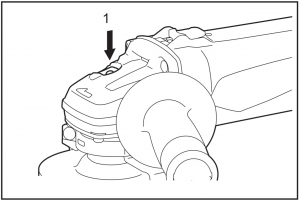 ► 1. Shaft lock
► 1. Shaft lock
| NOTICE: Never actuate the shaft lock when the spindle is moving. The tool may be damaged. |
Switch action
| ⚠ CAUTION: Before plugging in the tool, always check to see that the slide switch actuates properly and returns to the “OFF” position when the rear of the slide switch is depressed.⚠ CAUTION: Switch can be locked in “ON” position for ease of operator comfort during extended use. Apply caution when locking tool in “ON” position and maintain firm grasp on tool. |
To start the tool, slide the slide switch toward the “I (ON)” position by pushing the rear of the slide switch. For continuous operation, press the front of the slide switch to lock it.To stop the tool, press the rear of the slide switch, then slide it toward the “O (OFF)” position. ► 1. Slide switch
► 1. Slide switch
Unintentional restart proof
The tool does not start with the switch being lock-on even when the tool is plugged.To cancel the unintentional restart proof, return the power switch to OFF position.
| NOTE: Wait more than one second before restarting the tool when unintentional restart proof functions. |
| NOTE: When the tool is overloaded and the tool temperature reaches a certain level, the tool may automatically stop. In this situation, let the cool before turning on the tool again. |
Soft start feature
Soft start feature reduces starting reaction.
ASSEMBLY
| ⚠ CAUTION: Always be sure that the tool is switched off and unplugged before carrying out any work on the tool. |
Installing side grip (handle)
CAUTION: Always be sure that the side grip is installed securely before operation.
Screw the side grip securely on the position of the tool as shown in the figure.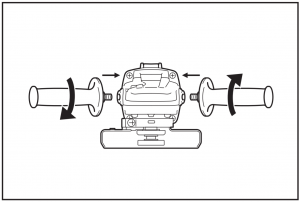
Installing or removing wheel guard (For depressed center wheel)
| WARNING: When using a depressed center wheel, the wheel guard must be fitted on the tool so that the closed side of the guard always points toward the operator. |
Mount the wheel guard with the protrusions on the wheel guard band aligned with the notches on the bearing box. Then rotate the wheel guard to such an angle that it can protect the operator according to work. Be sure to tighten the screw securely.To remove wheel guard, follow the installation procedure in reverse.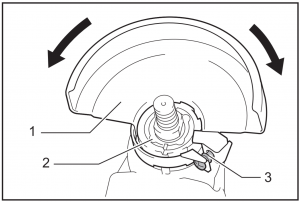 ► 1. Wheel guard 2. Bearing box 3. Screw
► 1. Wheel guard 2. Bearing box 3. Screw
Installing or removing depressed center wheel
Optional accessory
| ⚠ WARNING: When using a depressed center wheel, the wheel guard must be fitted on the tool so that the closed side of the guard always points toward the operator. |
| CAUTION: Make sure that the mounting part of the inner flange fits into the inner diameter of the depressed center wheel perfectly. Mounting the inner flange on the wrong side may result in the dangerous vibration. |
Mount the inner flange onto the spindle.Make sure to fit the dented part of the inner flange onto the straight part at the bottom of the spindle.Fit the depressed center wheel on the inner flange and screw the lock nut onto the spindle.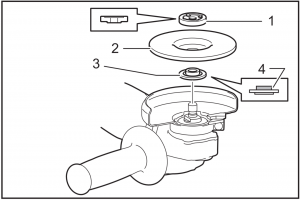 ► 1. Lock nut 2. Depressed center wheel 3. Inner flange 4. Mounting part
► 1. Lock nut 2. Depressed center wheel 3. Inner flange 4. Mounting part
To tighten the lock nut, press the shaft lock firmly so that the spindle cannot revolve, then use the lock nut wrench and securely tighten clockwise.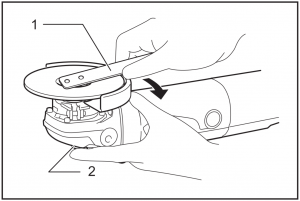 ► 1. Lock nut wrench 2. Shaft lock
► 1. Lock nut wrench 2. Shaft lock
To remove the wheel, follow the installation procedure in reverse.
OPERATION
| ⚠ WARNING: It should never be necessary to force the tool. The weight of the tool applies adequate pressure. Forcing and excessive pressure could cause dangerous wheel breakage.⚠ WARNING: ALWAYS replace wheel if tool is dropped while grinding.⚠ WARNING: NEVER bang or hit grinding disc or wheel onto work.⚠ WARNING: Avoid bouncing and snagging the wheel, especially when working corners, sharp edges etc. This can cause loss of control and kickback.⚠ WARNING: NEVER use tool with wood cutting blades and other saw blades. Such blades when used on a grinder frequently kick and cause loss of control leading to personal injury. |
| ⚠ CAUTION: Never switch on the tool when it is in contact with the workpiece, it may cause an injury to operator.⚠ CAUTION: Always wear safety goggles or a face shield during operation.⚠ CAUTION: After operation, always switch off the tool and wait until the wheel has come to a complete stop before putting the tool down.⚠ CAUTION: ALWAYS hold the tool firmly with one hand on housing and the other on the side grip (handle). |
Grinding operation
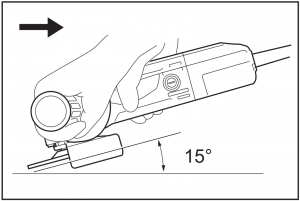
Turn the tool on and then apply the wheel or disc to the workpiece.In general, keep the edge of the wheel or disc at an angle of about 15° to the workpiece surface.During the break-in period with a new wheel, do not work the grinder in forward direction or it may cut into the workpiece.Once the edge of the wheel has been rounded off by use, the wheel may be worked in both forward and backward direction.
MAINTENANCE
| ⚠ CAUTION: Always be sure that the tool is switched off and unplugged before attempting to perform inspection or maintenance. |
| NOTICE: Never use gasoline, benzine, thinner, alcohol or the like. Discoloration, deformation or cracks may result. |
Replacing carbon brushes
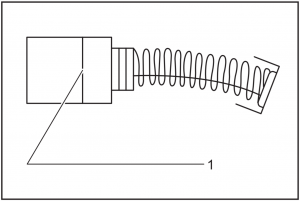 ► 1. Limit mark
► 1. Limit mark
Check the carbon brushes regularly.Replace them when they wear down to the limit mark.Keep the carbon brushes clean and free to slip in the holders. Both carbon brushes should be replaced at the same time. Use only identical carbon brushes.
- Use a screwdriver to remove the brush holder caps.
- Take out the worn carbon brushes, insert the new ones and secure the brush holder caps.
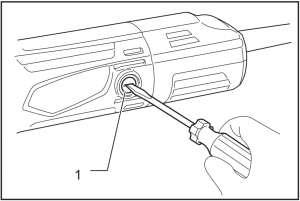 ► 1. Brush holder cap
► 1. Brush holder cap
To maintain product SAFETY and RELIABILITY, repairs, any other maintenance or adjustment should be performed by Makita Authorized or Factory Service Centers, always using Makita replacement parts.
Makita Europe N.V.Jan-Baptist Vinkstraat 2, 3070 Kortenberg, Belgium
Makita Corporation3-11-8, Sumiyoshi-cho, Anjo, Aichi 446-8502 Japan
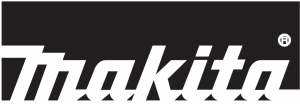
References
[xyz-ips snippet=”download-snippet”]

